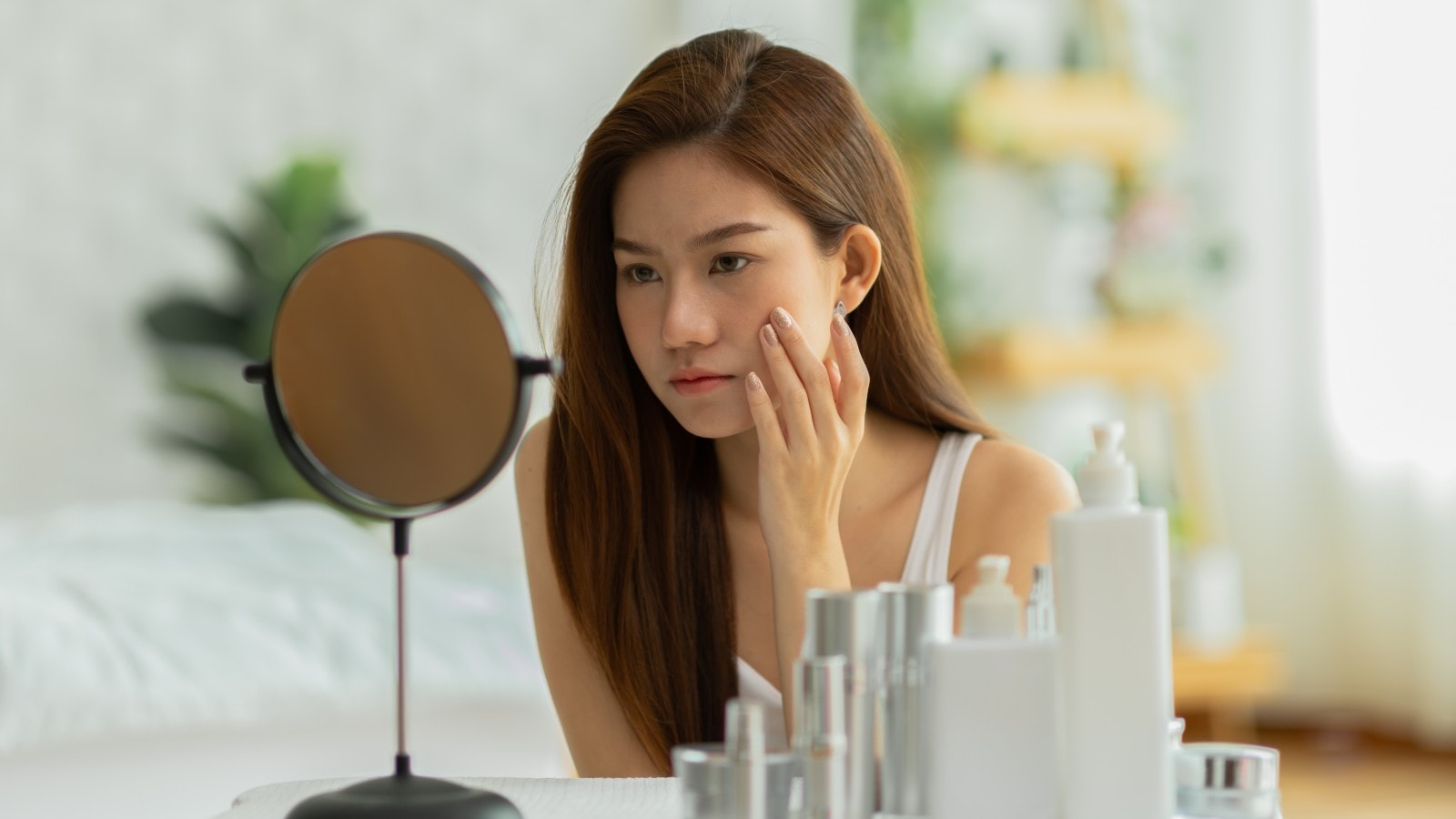
Skin problems in diabetes include eczema as well as fungal infections. Including these essential oils can provide quick relief.
Did you know that eczema, fungal infections, and skin tags are some of the most common skin problems in diabetes? Diabetes, a condition caused by the body’s inability to regulate blood sugar, can result in dehydration as well as poor blood circulation. This is what leads to many skin problems. However, using essential oils can help you keep these skin ailments at bay. These plant-based extracts are a natural home remedy to soothe, hydrate, as well as heal cuts and wounds, which are common with diabetic skin. Therefore, if you are looking for a good diabetic skincare routine, make sure to include these oils in it.
Can diabetes cause skin problems?
Yes, diabetes can lead to multiple skin problems due to the condition’s impact on the body’s systems. A study, published in the journal Cureus, revealed that the most common skin problems in diabetes are dry skin, itching, redness, scarring, and edema. The first and biggest reason for skin problems in diabetes is poor blood circulation. The condition can cause damage to blood vessels and this reduces blood flow to the skin. This makes it harder for the skin to receive the oxygen and nutrients it needs, impairing its ability to heal and function properly.

Additionally, harmful bacteria and fungi can thrive due to the high blood sugar in the body, increasing the risk of skin infections such as boils, fungal infections, and cellulitis. Another reason for skin problems in diabetes is frequent urination, which can lead to dehydration. Dry skin is more prone to cracking, itching, and infections.
Common skin problems in diabetes
Diabetes, a lifestyle disorder, is a condition that causes hormonal imbalance, and that impacts all organs of the body including the skin. “So, the common infections that patients with diabetes will get will be fungal, recurrent ringworms, recurrent fungal infections, yeast infections, pyoderma or bacterial infections, hair follicles infections which would trouble them,” explains dermatologist Dr Raina Nahar. Here are some of the other skin problems in diabetes:
- Diabetic dermopathy: This is a condition where the skin starts to get eczema, and leads to Pruritus (itchy skin), excoriation (skin picking, scratching).
- Diabetic foot: Here, in the soles of the feet, you will notice corns and calluses.
- Increasing number of skin tags: This is a skin problem in diabetes where you will see the outgrowth of the skin on the neck, underarms, groin fold etc. If there is a sudden burst of newer skin tags that are happening, you must identify and check the sugar levels.
- Acanthosis Nigricans: This is a condition where you can see a darkening of fold-area – knuckles, elbows, underarms, groin-area etc.
Diabetes patients are more prone to getting infections. “We always remind diabetic patients that this is an indicator (or trigger factors of diabetes). If they are getting a recurrent infection or if the itch threshold is increasing, they must check their sugar level, if there is a fluctuation in sugar levels or if it has increased,” explains Dr Nahar. These are all indicators that one can either have a flair-up (of blood sugar levels increasing) or chronic diabetes. In the skin, there are many markers which will help one identify, if one is diabetic.
Essential oils to treat skin problems in diabetes
Skin problems in diabetes can be severe. However, here are certain essential oils can help you get some relief:
1. Cold-pressed virgin coconut oil
Diabetes can often lead to dehydration, and cold-pressed coconut oil can help to keep skin hydrated. Coconut oil is an excellent natural moisturiser. It combats dry skin, which is a common issue in diabetes, explains the expert. Its occlusive properties lock in moisture and prevent water loss. For those who have eczema, diabetic dermopathy, or if they are having poor blood circulation, cold-pressed coconut oil will help as it has a lot of fatty acids which will help to hydrate and nourish the skin.
2. Sesame-seed oil
This oil is very helpful as it has Vitamin E. It has a lot of anti-inflammatory properties that can help treat skin problems in diabetes. Besides this, sesame seed oil contains sesamin and sesamol, which are compounds which also have anti-inflammatory properties. Sesamin could reduce inflammation, epidermal hyperplasia (skin thickening), collagen degradation, and wrinkle formation. These can soothe irritation and reduce inflammation caused by conditions like eczema or dry, cracked skin, which are unfortunate side effects of high blood sugar.
3. Tea Tree oil
Its antimicrobial, anti-inflammatory, and healing properties make it effective for addressing various skin problems in diabetes. This works like an antiseptic and prevents bacterial growth. It is effective against bacteria, fungi, and viruses. This makes it valuable for preventing and treating infections in cuts, wounds, and sores, which heal slowly in diabetics. “There are also anti-bacterial, anti-fungal creams as well but for those who want to take care of their skin through organic medications, Tea Tree oil is helpful for them,” explains Dr Nahar.
4. Avocado oil
This nourishes and moisturises the skin. Avocado oil is rich in monounsaturated fats, such as oleic acid. This penetrates deeply into the skin and locks in the moisture. Avocado oil helps combat the dry, flaky skin that is common in diabetes. Also, the oil contains vitamins A, D, and E. These support skin repair and regeneration. These nutrients accelerate the healing of minor cuts, wounds, and sores, which tend to heal slowly in diabetics.
5. Lavender Oil
There are many benefits of lavender oil when it comes to relieving skin problems in diabetes. It is excellent for treating symptoms such as skin irritation, itching, and inflammation. It’s particularly helpful for dry, cracked skin and eczema. Also, a study, published in the Journal of Alternative and Complementary Medicine, states that lavender oil has a faster rate of wound healing as well as shows increased expression of collagen. Lavender helps to heal minor cuts and wounds, which are common in diabetic skin.
6. Geranium Oil
Geranium oil can also help you deal with skin problems in diabetes. It helps to balance sebum production, which is very important for people with oily skin, especially one that is prone to acne. The essential oil is strongly antibacterial against selected microorganisms. It enhances blood circulation, promoting healthier skin, reducing the risk of skin ulcers and infections.
7. Chamomile Oil
Chamomile possesses potent anti-inflammatory properties and has been widely used in treating various skin diseases. Chamomile oil can calm irritated and inflamed skin problems in diabetes. It’s gentle enough for sensitive skin and can help relieve conditions like eczema and allergic reactions. It helps reduce redness and swelling caused by diabetes-related skin.
8. Rosehip Oil
Rosehip oil is packed with essential fatty acids and antioxidants, which help to regenerate skin cells and repair damaged skin. A study, published in the journal Planta Medica, states that rosehip oil significantly promotes wound healing and effectively improves scars. It also helps to diminish scarring caused by wounds, cuts, or skin ulcers.
How to use essential oils for skin problems in diabetes?
When you are a diabetic patient, your sensitivity to respond to any creams or oils can be a little different compared to normal people. “You can get allergic reactions, you can get folliculitis, so always remember to do a patch test. Apply a thin layer of the cream or oil, to begin with to test skin sensitivity. Later, use a moisturiser to soothe the skin,” explains Dr Nahar.

Also, always dilute essential oils with a carrier oil such as olive oil, or almond oil, to avoid skin irritation. A common dilution ratio is 3-5 drops of essential oil per 1 tablespoon of carrier oil. Make sure that you use a non-scented essential oil, as a lot of them come with fragrances, that can increase your allergy levels. Also, use the right moisturiser which will help to soothe the skin.
If you have sensitive skin or severe skin problems due to diabetes, consult your doctor or a dermatologist before using essential oils, especially if you’re on medications or undergoing treatments.
Related FAQs
Can essential oils help with diabetic skin infections?
Yes, there are many essential oils like tea tree oil as well as lavender oil that have antimicrobial properties that can help prevent and treat skin infections that are common among diabetics. These oils can also help reduce swelling and redness associated with infections.
Can I use essential oils every day?
Yes, can use essential oils for skin care once or twice daily, depending on the severity of the skin issue. Always apply them after cleansing your skin and follow up with a moisturizer. Be consistent for best results, but do not overuse them, as that could lead to irritation.






